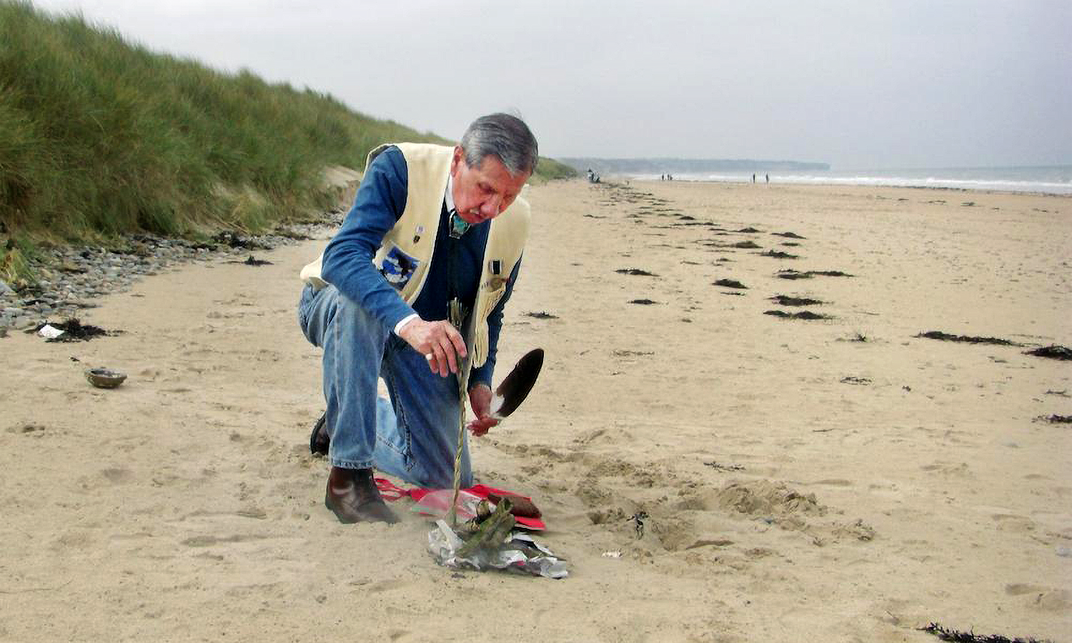NATIONAL MUSEUM OF THE AMERICAN INDIAN
On the 75th Anniversary of D-Day, Native Americans Remember Veterans’ Service and Sacrifices
This year, 80 Native delegates have been asked to take part in the official commemoration of D-Day. Their responsibilities include offering ceremonies at American cemeteries and memorials in Normandy to honor the men and women who served during World War II—part a growing movement to acknowledge the historic service of Native Americans, Alaska Natives, and Native Hawaiians in the U.S. Armed Forces.
:focal(783x363:784x364)/https://tf-cmsv2-smithsonianmag-media.s3.amazonaws.com/blogging/featured/Julia_Kelly_1500x800.png)
“I have full confidence in your courage, devotion to duty, and skill in battle. We will accept nothing less than full victory! Good luck! And let us all beseech the blessing of Almighty God upon this great and noble undertaking.” —General Dwight D. Eisenhower, Supreme Allied Commander, addressing Allied troops before the Normandy landing
Eighty Native American delegates have traveled to France to commemorate the 75th anniversary of D-Day. On June 6, 1944, the largest amphibious invasion in history began as Allied forces landed on the Normandy coast. Some 160,000 soldiers, sailors, and airmen, aboard 5,000 ships and 13,000 aircraft, stormed the beaches to establish a foothold for the liberation of Western Europe. Among those troops were American Indians who, like their ancestors, accepted the responsibilities of warriors.
The Native representatives taking part in the commemoration are members of the Charles Norman Shay Delegation, named for a decorated Penobscot Indian veteran of the Normandy invasion. “We are going to support D-Day anniversary activities during ten days of events,” says Command Sergeant Major Julia Kelly, an enrolled citizen of the Crow Tribe and one of five Native women in the delegation representing the United Indigenous Women Veterans. “They will keep us very busy.”
A U.S. Army medic from Indian Island, Maine, Private Shay was attached to one of the first regiments to land on Omaha Beach, the most heavily defended sector of the coast. Shay began treating the wounded as soon as he got his footing, dragging wounded soldiers out of the surf under constant fire. After the war, the U.S. Army awarded Shay a Silver Star for his actions, and the French government appointed him a Chevalier of the Légion d’honneur, the highest honor given to noncitizens of France.
Two years ago today, on the 73rd anniversary of D-Day, in a park overlooking Omaha Beach, the people of Normandy dedicated the Charles Shay Memorial. The first French monument to honor American Indian soldiers who fought on D-Day, it is part of a growing movement to acknowledge Native Americans’ contributions during World War II. To Shay, the simple stone turtle that stands as the park’s monument represents all the “Indian soldiers who left Turtle Island to help liberate our allies.”

During the 75th anniversary commemorations, Command Master Sergeant Kelly and the other Shay delegates are attending services at the Normandy American Cemetery, where at least 29 Native soldiers are buried; the Brittany American Cemetery, where at least nine Native soldiers are buried; the Charles Shay Memorial; and the Utah Beach American Memorial, where they will honor 30 Comanche soldiers from Oklahoma. In 1944, Comanche Code Talkers exchanged radio messages detailing the exact landing locations for each group of Allied Forces as their ships reached the beaches of Normandy. The delegates will also take part in a conference on the role of Native Americans in Normandy and throughout World War II.
According to Dr. Harald E. L. Prins, an anthropologist and researcher at Kansas State University, 175 Native soldiers landed on Omaha Beach on D-Day; to date, the Department of Defense has identified 55. Department of Defense figures show that more than 44,000 Native Americans served throughout the U.S. military between 1941 and 1945. Nearly 800 Native American women served as well, according to Judith Bellafaire, Ph.D., curator of women in military service for the Women in Military Service for America Memorial Foundation. Native women served as members of the WAVES (Women Accepted for Volunteer Emergency Service), WACS (Women Army Corps), and Army Nurse Corps.
The 44,000 Native American men who served represent more than ten percent of the American Indian population at that time. A third of Native men between the ages of 18 and 50 served. Some tribes had as high as 70 percent participation in the war effort. All three of Charles Shay’s brothers served during the war, two in the U.S. Navy and one in the Army Air Corps. “There were mothers across Turtle Island praying for their brave sons,” he says.
This September, the National Museum of the American Indian in Washington, D.C., will break ground for the National Native American Veterans Memorial to honor the service and sacrifice of all Native Americans veterans of the armed forces and their families. The memorial will be dedicated in a public ceremony on November 11, 2020.
